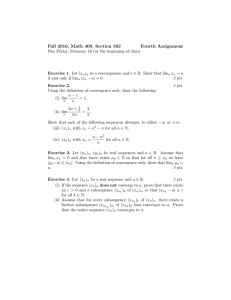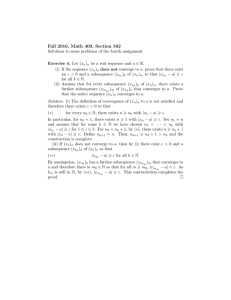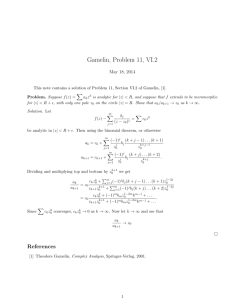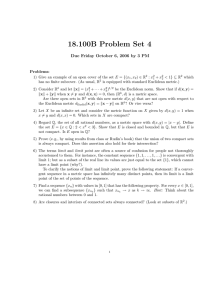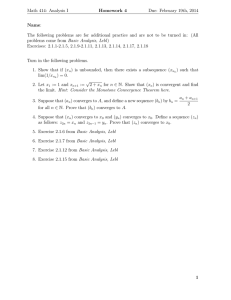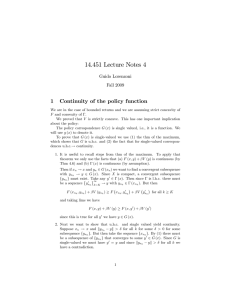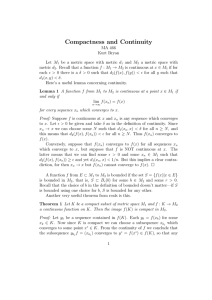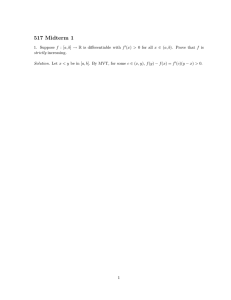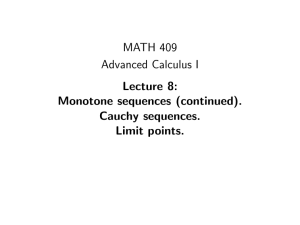1
advertisement
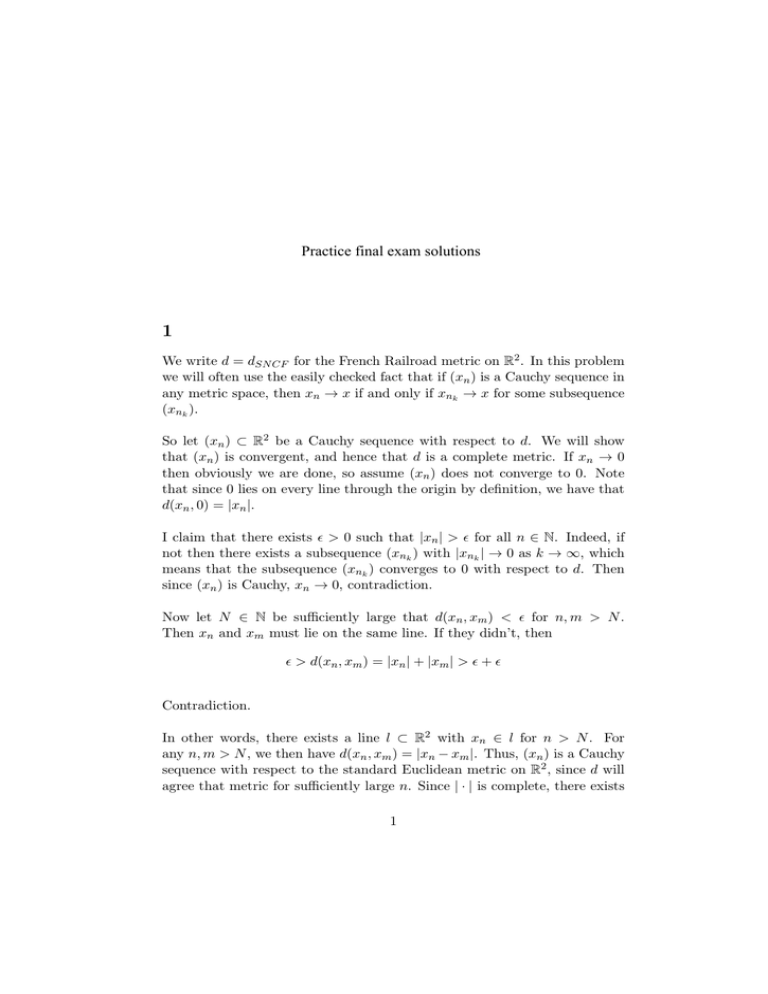
Practice final exam solutions
1
We write d = dSN CF for the French Railroad metric on R2 . In this problem
we will often use the easily checked fact that if (xn ) is a Cauchy sequence in
any metric space, then xn → x if and only if xnk → x for some subsequence
(xnk ).
So let (xn ) ⊂ R2 be a Cauchy sequence with respect to d. We will show
that (xn ) is convergent, and hence that d is a complete metric. If xn → 0
then obviously we are done, so assume (xn ) does not converge to 0. Note
that since 0 lies on every line through the origin by definition, we have that
d(xn , 0) = |xn |.
I claim that there exists E > 0 such that |xn | > E for all n ∈ N. Indeed, if
not then there exists a subsequence (xnk ) with |xnk | → 0 as k → ∞, which
means that the subsequence (xnk ) converges to 0 with respect to d. Then
since (xn ) is Cauchy, xn → 0, contradiction.
Now let N ∈ N be sufficiently large that d(xn , xm ) < E for n, m > N .
Then xn and xm must lie on the same line. If they didn’t, then
E > d(xn , xm ) = |xn | + |xm | > E + E
Contradiction.
In other words, there exists a line l ⊂ R2 with xn ∈ l for n > N . For
any n, m > N , we then have d(xn , xm ) = |xn − xm |. Thus, (xn ) is a Cauchy
sequence with respect to the standard Euclidean metric on R2 , since d will
agree that metric for sufficiently large n. Since | · | is complete, there exists
1
x ∈ R2 with limn→∞ |x−xn | = 0. Lines are closed subsets of R2 with respect
to | · |, so x ∈ l. Then d(xn , x) = |xn − x|. Thus xn → x with respect to d,
and so d is complete.
2
Let E = Q ∩ [0, 1]. E is an infinite subset of a countably infinite set,
hence is countably infinite. In other words, there exists a bijective function
f : N → E. Define the sequence (xn ) via xn = f (n). Note that E = [0, 1]
Let F be the set of all subsequential limits of E. I claim that F = [0, 1].
Suppose that x ∈ F . Take a subsequence (xnk ) converging to x. Then every
neighbourhood of x contains all but finitely many (xnk ), and in particular
intersects E. So x ∈ E = [0, 1].
Conversely, suppose x ∈ [0, 1]. We will construct a subsequence xnk → x
inductively. Let n1 = 1. Suppose we have definted n1 , n2 , . . . nk . Consider
the subset Ak+1 ⊂ N, defined by
Ak+1 = {n ∈ N||x − f (n)| <
1
}
k
Recall that xn = f (n). Since x is a limit point of E, B1/k+1 (x) contains
infinitely many points of E; since f is surjective, this implies that Ak+1 is
infinite. Thus we can pick a nk+1 ∈ Ak+1 with nk+1 > nk .
Thus we have constructed a subsequence (xnk ) with |x − xnk | < 1/k, which
means that xnk → x, so x ∈ F . Thus F = [0, 1] and we are done.
3
We have a continuous function f : [0, 1] × [0, 1] → R. For a fixed x ∈ [0, 1],
consider the function hx : [0, 1] → R defined by hx (y) = f (x, y). Then hx
is continuous; indeed, for any y ∈ [0, 1] and E > 0, take a δ > 0 that works
for f and E at (x, y). Since hx is a continuous function on a compact set,
it attains a finite maximum; in other words, for some y0 ∈ [0, 1], we have
f (x, y0 ) = hx (y0 ) ≥ hx (y) = f (x, y) for all y ∈ [0, 1]. Then
g(x) = sup {f (x, y)} = f (x, y0 )
y∈[0,1]
2
Is well defined. We need to show that g : [0, 1] → R is continuous. Note that
we have not only proved that g is well defined, but have also shown that for
any x ∈ [0, 1], there exists y ∈ [0, 1] with g(x) = f (x, y).
Let x ∈ [0, 1]. We need to show that limz→x g(z) = g(x). So suppose
this is false. Then there exists E > 0 and a sequence (xn ) with xn → x but
|g(xn ) − g(x)| > E.
For each xn , pick yn ∈ [0, 1] such that g(xn ) = f (xn , yn ). Now consider
the sequence ((xn , yn ))n∈N . This a sequence in the compact set [0, 1] × [0, 1],
hence has a convergent subsequence. In other words there exists (x/ , y / ) ∈
[0, 1] × [0, 1] with (xnk , ynk ) → (x/ , y / ). This implies that xnk → x/ , but since
this a subsequence of a convergent sequence, it must also converge to x, and
so x/ = x.
f is continuous, and so
f (x, y / ) = lim f (xnk , ynk ) = lim g(xnk )
k→∞
k→∞
Hence, we must have |g(x)−f (x, y / )| ≥ E. Pick y ∈ [0, 1] with f (x, y) = g(x).
Then f (x, y) ≥ f (x, y / ), by the definition of g, and so
f (x, y) − f (x, y / ) ≥ E
On the other hand, f is uniformally continuous, since it is a continuous
function on a compact set. Pick a δ > 0 such that
d((z, w), (z / , w/ )) < δ =⇒ d(f (z, w), f (z / , w/ )) < E/3
√
and k sufficiently large that |x − xnk |, |y / − ynk | < δ/ 2. Then |f (x, y) −
f (xnk , y)| < E/3, and so
f (xnk , y) > f (x, y) − E/3
Similarly, |f (xnk , ynk ) − f (x, y / )| < E/3, and so
f (x, y / ) + E/3 > f (xnk , ynk )
3
Putting these together, we have
f (xnk , y) > f (x, y) − E/3 > f (x, y / ) + E/3 > f (xnk , ynk )
This is a contradiction, since f (xnk , ynk ) = g(xnk ) = supy {f (xnk , y)}.
4
We will show that g / (x0 ) = f // (x0 )/2 by directly evaluating the limit of
difference quotients. We have
g(x) − g(x0 )
lim
= lim
x→x0
x→x0
x − x0
f (x)−f (x0 )
x−x0
− f / (x0 )
x − x0
= lim
x→x0
f (x) − f (x0 ) − (x − x0 )f / (x)
(x − x0 )2
Note that both the numerator and the denominator of the above expression
converge to 0 as x → x0 . Since f is twice differentiable at x0 , it must
be once differentiable in some neighbourhood of x0 , otherwise the second
derivative would not even make sense. Thus we can apply L’Hopital’s rule;
the derivative of the numerator is f / (x) − f / (x0 ), while the derivative of the
denominator is 2(x − x0 ). In other words, we have
lim
x→x0
g(x) − g(x0 )
f / (x) − f / (x0 )
f // (0)
= lim
=
x→x0
x − x0
2(x − x0 )
2
In particular, the limit exists, i.e. g is differentiable at x0 .
5
f is integrable, with integral 0. Note that any closed interval [x, y] with
x < y contains a point z with f (z) = 0. Since f is non-negative, this implies
that for any partition P , we have L(f, P ) = 0.
Let E > 0. We will find a partition P with the upper Riemann sum U (f, P ) <
2E, which will prove the result. Consider the function g : [E, 1] → R, which
is equal tof restricted to the interval [E, 1]. g has only finitely many points
of discontinuity, namely, the finitely many points of the form 1/n > E for
4
n ∈ N. Hence by Rudin Theorem 6.10, g is integrable. Since all lower
Riemann Sums of g are zero, we must have
1
g(x) = 0
1
In particular, there exists a partition P of [E, 1] with U (g, P ) < E.
Now consider the partition of [0, 1] defined by P / = P ∪ {0}. Then all
but the first term of U (f, P / ) is contained in U (g, P ). More precisely, we
have
U (f, P / ) = ( sup f (x))(E − 0) + U (g, P ) < E + E = 2E.
x∈[0,1]
Which proves the result.
6
Since f : [0, 1] → R is integrable, it is bounded, i.e. |f (x)| < M for all
x ∈ [0, 1]. We may assume M > 1. Let E > 0. Let δ < E/(2M ).
Note that 0 < 1− δ < 1, and so by Rudin Theorem 3.20 limn→∞ (1 −δ)n = 0.
Let N be sufficienly large that n > N =⇒ (1 − δ)n < δ. Then for any
0 ≤ x ≤ 1 − δ and any n > N , we have xn < δ. Hence for n > N , we have
1−δ
1−δ
f (x)xn dx ≤
0
1−δ
|f (x)|xn dx <
0
M δdx < M δ <
0
E
2
On the other hand xn ≤ 1 for x ∈ [0, 1], and so
1
1
f (x)xn dx <
1−δ
1
|f (x)|xn dx <
M dx = M δ <
1−δ
1−δ
E
2
Putting these together, we have
1−δ
1
f (x)xn dx ≤
0
1
f (x)xn dx <
f (x)xn dx +
1−δ
0
5
E
E
+ = E.
2 2
Thus limn
�1
0
f (x)xn dx = 0.
6
MIT OpenCourseWare
http://ocw.mit.edu
18.100C Real Analysis
Fall 2012
For information about citing these materials or our Terms of Use, visit: http://ocw.mit.edu/terms.
